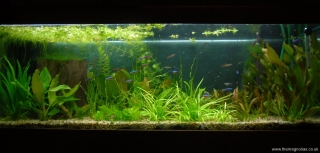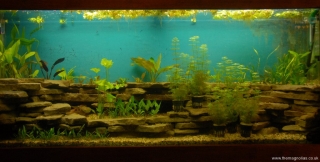Happy New Year reader.
What a beautiful day for New Year’s Day 2013. The sunshine drew us outside to make a start on mulching our perennial and rose beds, with our own homemade compost. In two sessions today we have completed about half the job.
Anyway, back to the second half of the aquarium story. This time instead of asian tanks it is South American ones, or at least mostly from the Amazon area.
For quite a few years we have been running a fairly purist, four foot aquarium planted with Echinodorus or Amazon Sword Plants and a few other plants from the region. The tank is stocked with fish from the same area, including Engler type Guppies and various Characin species including several Tetras, Cardinal Tetras being in the greatest number. Amazon sword plants tend to need more light than Cryptocoryne species so we run three T8 fluorescent tubes. In addition they respond well to CO2 and feeding, producing colourful new leaves in succession.
This tank had suffered a bit from neglect over the 2012 three main gardening seasons, especially because the CO2 had not been kept going at times. We have now pulled it back fairly well.Our third big project of the winter has been an attempt to seal a five foot long, two foot deep aquarium that had been empty for at least five years following a hisory of leaking. The tank was built about forty five years ago and was quite unconventional. The bottom of the tank is a sheet of stainless steel, with the edges turned up at right-angles. Onto this has been welded a mild steel aquarium frame. It was then glazed with putty. The problem was the stainless steel base flexes easily if there is any movement in the base it is stood on.
The tank had been in two other peoples homes when I got it over forty years ago. I constructed what I thought was a sufficiently rigid stand and further sealed the bottom stainless steel to glass seams with melted tar. It was fairly well behaved for many years until we drained it following intolerable leaking. The problem of doing further work to the various glass to glass and metal seams was lack of access to some areas as large rock features were built into the design on its initial set up, here.
Following the two Crypt tank projects we cleaned out this tank of gravel and soil and then attempted to seal the seams which could be accessed, using more modern sealants. Normal aquarium silicon sealant was used glass to glass, vertical corners with a black mastic used on the glass to metal seams at the bottom. In order to have no glass lids between the lights and the water it was necessary to encase the mild steel top frame of the tank in strips of glass to protect it from rusting.
Above this is a hood constructed of 4mm mirror built onto a wood and hardboard frame, which is hinged onto the wall at the back and has counter balance weights on cables through pulleys to take the considerable weight of the mirrored hood.The tank leaked rather worryingly for a day or two but further applications of mastic and resin adheasive to the outside combined with swelling of the ancient dried out putty and the water drips ceased.
I went on line again looking this time for Echinodorus and ordered quite a few exciting looking new ones. The tank has a long way to go especially before we can put any animals into it as it has been showing high levels of ammonia, nitrite and nitrate. This we think is because we used a quantity of recycled gravel which had been used as a substrate in a lizard tank. Although it was washed repeatedly it seems it wasn’t enough as the readings are exceedingly high. We are having to do daily partial water changes to lower the dangerous readings. After three daily, partial water changes the plants are looking happier at least!
I will post again when there is more to report on these projects.


